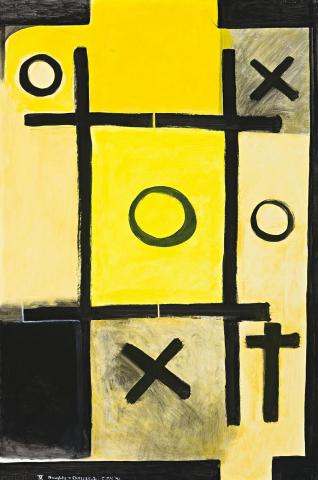NOUGHTS AND CROSSES, SERIES 2, NO. 5, 1976
Colin McCahon
synthetic polymer paint on Steinbach paper mounted on hardboard
109.5 x 72.5 cm
signed, dated and inscribed lower left: V Noughts & CROSSES - 2. C.McC & '76
Barry Lett Galleries, Auckland
Kim Wright collection, Auckland
Thence by descent
Rachel Power collection, Auckland
Martin Browne Fine Art, Sydney
Private collection, Sydney
Colin McCahon: Paintings—Noughts and crosses, Rocks in the sky, On the road, Barry Lett Galleries, Auckland, 23 August—3 September 1976, cat. 2 (as Noughts and Crosses (second set) with five other works from the same series)
Colin McCahon: A Question of Faith, Stedelijk Museum, Amsterdam, 30 August—10 November 2002; City Gallery, Wellington; Auckland Art Gallery Toi o Tamaki, Auckland; National Gallery of Victoria, Melbourne; Art Gallery of New South Wales, Sydney, 2002–2004
Bloem, M. and Browne, M., Colin McCahon: A Question of Faith, Craig Potton Publishing & Stedelijk Museum, Amsterdam, 2002, p. 135 (illus.), p. 226
Colin McCahon Online Catalogue, www.mccahon.co.nz, ref: cm001522
Noughts and Crosses, series 2, nos. 2,3, 4, 6, 7, 1976, listed in Colin McCahon Online Catalogue, www.mccahon.co.nz
Inspiration for the Noughts and Crosses came to Colin McCahon while watching his daughter Victoria play games of noughts and crosses with her young sons. In their discarded scraps of paper covered in completed games, McCahon found a rich metaphor for the universal 'game' of life. For in life, as in noughts and crosses, each individual must play within a given set of rules, the choices made and chances taken determining what follows thereafter.
Exploring the striking visual possibilities offered by the layout of the game, the artist produced a series of taut and unambiguous paintings in which this simple children's game became a diagram of life and death. Now the crosses represented both a positive and affirmative act and, through the metaphor of the Crucifixion, the promise of redemption. As well as the 'x' traditionally used as the 'cross' in the game, in these paintings McCahon employs the shape of the Latin Cross "T'' the Cross of Christ's Crucifixion. By contrast, the noughts here threaten the possibility of the abyss; a primordial void from which there is no hope of escape.
The overall series known as Noughts and Crosses comprises 14 paintings (again a reference to the 14 Stations of the Cross) and is divided into two sets of seven, known as 'the first set' and 'series 2'. Each of' the first set' depicts two completed games and common to all but one is the victory of the crosses. In each case the cross depicted is the Latin Cross of the Crucifixion rather than an 'x'. The sole exception is the upper game of Noughts and Crosses 7 (cm001439), the last in 'the first set', in which there is a 'win' for both the noughts and the crosses - a result impossible in a real game where the first to achieve a complete line wins. But in the lower game of no. 7 victory returns to the Latin Crosses.
In 'series 2' the imagery is reduced to single games and their results become more ambiguous. Of the five works of the seven 'series 2' paintings illustrated on the Colin McCahon Database and Image Library (http://www.mccahon.co.nz/browse/series/1511) only no. 3 repeats the victory of the Latin Crosses that distinguished 'the first series'. Instead in no.s 4 and5 (the work offered here), the games are inconclusive - reflecting the more usual state of human existence - while in no. 6 the victory of the crosses is rendered with a line of bold black 'x's rather than the Latin Crosses used earlier. The ambiguity of whether this is really a victory is emphasized by the drama of these inky black crosses placed over a background dense with smoke from a fiery hell. Finally, in no. 7, the last painting of the 14, the hope offered by the Latin Cross has been extinguished: the crosses here appear in black against a black background while victory lies with the noughts.
Despite such an apparently bleak and nihilistic finale, there is no doubting the power of McCahon's Noughts and Crosses paintings. Nowhere is the artist's genius for taking simple ideas based on everyday life and developing them into compelling visual renderings of universal truths better illustrated than in these paintings - and Noughts and Crosses, series 2, no. 5 is one of the group's finest.
WE ARE GRATEFUL TO MARTIN BROWNE FOR HIS ASSISTANCE WITH THIS CATALOGUE ENTRY
